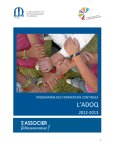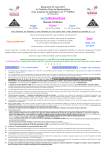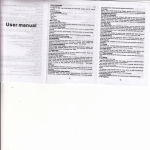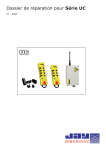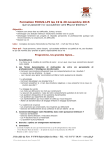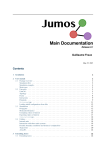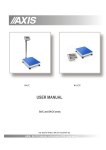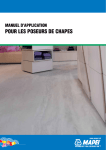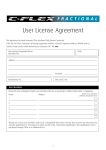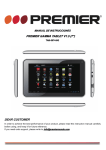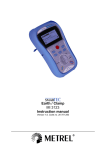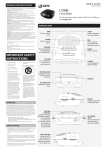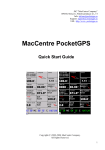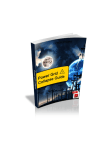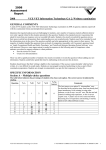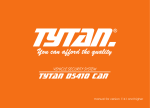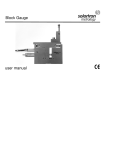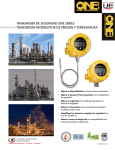Download User manual WG407
Transcript
ATMOR sc Elektronika Pomiarowa 80-809 Gdańsk, ul. Chałubińskiego 29 tel., fax (0-58) 679-56-56, 0-601-68-78-53 Gdańsk, 2008 USER MANUAL EARTHING IMPULSE METER TYPE WG-407 1. Description of the meter 1.1. General remarks A meter WG-407 has been designed for earthing resistance measurements at impulse time parameters similar to those met at real atmospheric discharges. The applied impulses achieve a value of about 1 A at a voltage of about 1000 V. Time parameters of the measurement impulses fulfil requirements of the following standards: PN-92/E-04060 and PN-EN 60060-2:2000. The meter has been designed for checking of all lightning protection earthings, especially in objects submitted to increased rigours and specially protections required by PN-89/E-05003/3 and PN-89/E-05003/4, for example petrol or gas stations. The meter is eapecialy useful for measurements of transmission line tower earthings. Resistance tests of line tower earthings by means of clasic low frequency meters need disconnection of the tested earthing from the tower, so it is time consuming and the line must be switched off. Use of impulse current makes tower earthing tests without disconnections and, what is more, they can be done on line in service. There can be applied different definitions of impulse resistance, as well as of operating temporary values, but only the definition using peak values of current and voltage drop has found practical realization. Such a way corresponds to the European Standard PN-IEC 61024-1, where a definition of an "earthing equivalent resistance" is explained as "a ratio of maximum values of voltage drop and current, whitch usually are not at the same time". 1.2. Technical data 1. Two measuring ranges (automatic selection): 0 – 19.9 Ω and 20.0 – 199 Ω 2. Errors: basic error 2.5 %, total error 5.0 % 3. Power supply: internal battery 4.8 V Cd-Ni, 1 Ah with discharge and charge control system. The battery is sufficient for about 1000 measurements. 4. LCD display – 2 and half significant digits 5. Dimensions: 100 x 195 x 40 mm 6. Weight: meter – 0.4 kg, with accessories – 3.7 kg • 2 stakes (φ 10 mm, 0.6 m long) • single conductors 1x0.75 mm2: 1) current probe – 40 m, 2) voltage probe – 30 m 3) tested earthing – 2 m • net power supply 1.3. Description of the meter 1 2 3 4 5 6 8 7 10 9 Fig. 1. Meter WG-407 - a general view 2 The meter can bee seen in Fig. 1, where: 1 - switch "Zasil" - the meter is turn on and off, on a LCD display appears an inscription: ATMOR WG407 and a few seconds later "Menu measure" 2 - “Zx” – a socked to be connected with the tested earthing 3 - “Su” – a socked to be connected with the voltage probe 4 - “Si” – a socked to be connected with the current probe 5 - LCD – a liquid crystal display, the display may be light up by pushing a button "+" 6 - a button "Start" - when you push that button a measurement or another process chosen by the button "Menu" is started, 7 - a button "Menu" - a choice of operation mode of the meter: a) measurement b) memory service: writing, reading or erasing measurement results c) battery test 8 - a button "+" - an increase of a number of a read memory cell or light up the display after measurement 9 - a button "-" - a decrease of a number of a read memory cell 10 - a battery charging socked 1.4. Meter accessories The WG-407 meter with its accessorie has been shown in Fig. 2 Rys. 2. General view of the meter and its accessories: 1- the meter WG-407, 2 –bag, 3 – reel with conductors, 4 – net power supply for battery charging, 5 –protective coverof measurement probes 3 2. Measurements 2.1. Safety of service It is not allowed to connect the meter measurement sockeds to any voltage source. The WG 407 meter has not designed for short circuit loop resistance measurements! During the meter operation industrial safety rules should be applied. The meter is supplied from a battery of 4.8 V and it generates impulse currents of about 1 A at a voltage of about 1000 V. Front times of the applied impulses are equal to 4 µs. Pulse rate of the meter is equal to about 5 per second. If somebody touch an output socked of the meter an current amplitude is decreased by human body resistance (about 3 kΩ). Current impulses of such amplitude and such short duration are not dangerous for peoples, but they can be very unpleasent for somebody touching a measurement circuit. It is not allowed to use: • a humid or damaged meter • measurement conductors with out of order insulation 2.2. Conditions of correct measurements In order to obtain correct measurement results the following coditions has to be performed: • Resistance of both current and potential probes should be less than 1000 Ω. In opposite situation when you push the button "Start" an inscription "ERROR! VOLTAGE" or "ERROR! CURRENT"is shown. A test can be carried out if probe resistance is reduced, for example biger stakes or a few stakes connected in parallel. • In order to reduce an influence of electromagnetic coupling on obtain measurement results probe coductors should be placed at a distance of more than 5 m between them. This condition may be easy meet when the probes are arranged in a configuration shown in Fig. 3 Fig. 3. A suggested configuration of measurement probes 2.3 Measuring, writing, reading and erasing procedures 2.3.1 Measuring • Drive probes into soil, reel off conductors and connect them to the meter taking into consideration remarks mentioned in p. 2.2, 4 • • Power on the meter using swich “Zasil”, wait until the display shows the inscription "ATMOR WG 407" and a few seconds later the inscription “Menu measure”, the meter is ready to measurement, Push the button “Start”, the meter perform a mesurement circuit test (the inscription "testing circuit") and the display shows a result of a tested earthing - an inscription: "me? Menu ...Ω Ω". In this state yuo can light up the display pushing the button "+". Every following pushing the button “Start” starts a mesurement procedure. If you see the inscriptiont "ERROR! VOLTAGE" or "ERROR! CURRENT" instead of an measurement result, measurement circuit resistance seems to be to high - see p. 2.2. 2.3.2 Writing, reading and erasing procedure in memory • In order to write a measurement result shown on display you should push the button “Menu” , the inscription “write Me ... Ω” appears and when you push the buttonu “Start”, a result from the display is writen in the meter memory and an inscription "OK ... Me ...Ω Ω” appears on the display. A number in the first part of the inscription shows a position of the writing in the meter memory. A result is writen at the lowest free position. When you push the button “Start” at the inscription "OK ... Me ...Ω Ω”, a measurement procedure is started again without change of operation mode by usage of the button “Menu”. • In order to read writen in the memory results you should push the button “Menu” until an inscription “Menu read” appears and then push the button “Start”. An inscription “# ## ... Me ...Ω Ω” on the display appears, where the first number denotes a position of a result shown on a second position. You can change the read position by pushing the buttons "+" or "-". • A storage capacity is able to read 126 results. In order to erase and clear the meter memory you should find an inscription “write Me” or “write Me ...Ω Ω”, next push and keep the button “+”, then push and keep the button “-“, afterwards you should release the pushed button “+”, and the button “-“ must be kept until you see an inscrition “clear Me”, afterwards release the pushed button “-“. If you push the button “Start” at the inscrition “clear Me” all results writen in the meter memory are erased. 3. Supply system of the meter 3.1 Battery test The meter WG-307 is powered by a 4.8 V Cd-Ni battery. A battery set of capacity 700 - 1000 mAh as usualy the meter is equipped seems to be sufficient to perform about 1500 measurements. A battery container there is under a cover on a rear panet of the meter. You can remove the cover pushing the cover in a direction shown by an arrow with inscripion „OPEN”. In order to check a battery charging ratio you should push the button „Menu” until an inscription „Bat. Menu Test” appears and then push the button „Start”. The meter starts to test the battery (an inscription „Test bat. >>>”) and finaly an inscription „Test bat. ...%” appears. The number denotes a level of battery charge. When a battery voltage becomes to low, the meter resets and on its display appears an inscriptiona "ATMOR WG 407". 3.2 Battery charging The meter is equipped with inner charging system and the battery can be charged without taking out the battery from a container. In order to start with battery charging procedure you should swich off the meter and a net power supply pin must be plug to the meter socked. The meter starts with a charging procedure automaticaly. At the begining the charging level of the battery is checked and on the display appears an inscription „Charger test bat”. If the battery level is higher than 30% of rated one, an inscription 5 „Charger Ful” and the battery is not charged. In opposite situation a two stages charging process starts. First stage refers to battery discharging - an inscrition „ Charger discharg”. In the second stage appears an inscription „Charger charging” and the meter starts to charge battery. When you noticed an inscription „ Charger Full” it denotes that the charging process has been finished. 4. Maintenance • Electrical circuit of the meter does not require maintenance. Accuracy check of the meter should be done accordingly to Producer’s Standard WT-06-01/407. • The meter is powered with NiCd accu pack of 4.8V. In emergency 4 AA alkali batteries can be used. • Battery compartment is on the back of the meter. • The confirmation of the accuracy is made in Okregowy Urząd Miar in Gdańsk (PL). 5. Warranty The producer gives 1-year warranty. The warranty card is on the last page of the manual user. ATMOR sc Elektronika Pomiarowa ul. Chałubińskiego 29 80-809 Gdańsk office adress.: ul. Kujawska 4/9, 84-232 Rumia tel., fax (0-58) 679-56-56, 0-601-68-78-53 Warranty of EARTHING IMPULSE METER Type WG-407, Nr _____________________ Gdańsk, date________________________________________ 1. 2. • • • • 3. Date The producer gives 1-year warranty Warranty does not cover the results of improper exploitation mechanic fatigue pouring liquids improper battery wrong battery polarisation The battery is not the subject of warranty signature of seller 6






